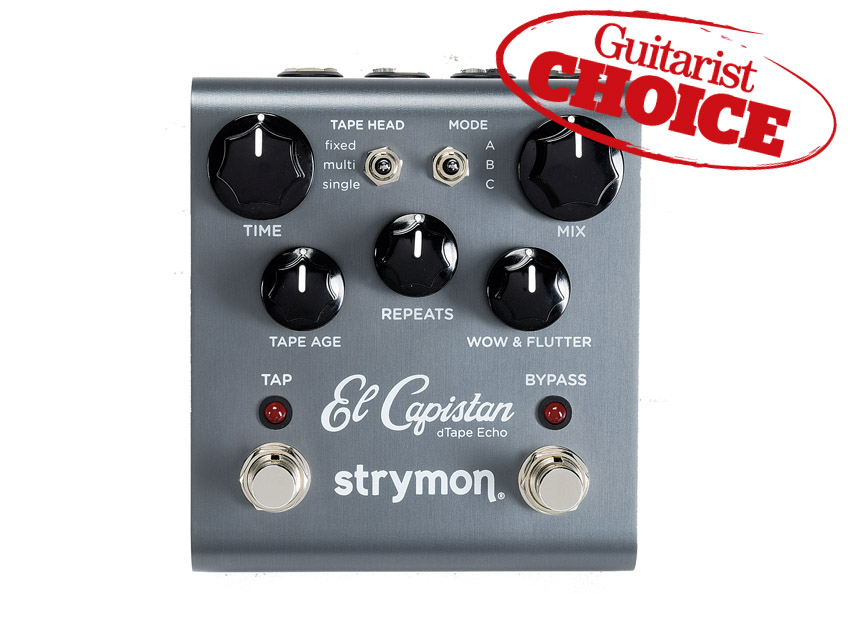MusicRadar Verdict
A great all-round delay, perfect for any guitar and amp set-up.
Pros
- +
Accurate emulation. Adjustable parameters. Looping. Tap tempo.
Cons
- -
Secondary functions access.
MusicRadar's got your back
The El Capistan aims to make the sound of a tape echo available in a stompbox by using Strymon's dTape technology which, says the company, "models all of the complexities of tape machines including such factors as wow and flutter, tape friction, bias adjustment, oscillation, saturation and delay-time-adjustment artefacts."
Three tape echoes are modelled - a three-way switch selects the types while a second three-way mode switch offers variations on each. Fixed represents a single head tape echo - and although it has three heads, these are selected individually by the second switch.
Multi is a multi-head machine with the mode switch selecting one of three head combinations (1&2, 2&3, 1&3). Single is the moveable head machine and the mode switch calls up normal or double tape speeds plus a sound-on-sound mode that effectively gives you looping capability.
The usual mix, delay time and repeats knobs are complemented by knobs to adjust tape age (making the repeats darker) plus wow & flutter (modulation). If that's not enough, all five knobs have secondary functions (accessed by holding down the tap and bypass switches) including adding spring reverb and adjusting tape bias, tape crinkle, low-end contour and the boost or cut amount.
Sounds
Alongside vintage Space Echo and Copicat units, this compares well: it sounds excellent and gets pretty close to real tape echo tone. There's a lot of sonic variation available, but we'd prefer dual-concentric knobs rather than holding down switches to access secondary functions.
The tonal range and character of the repeats is very adjustable so you can have fairly bright clean-ish repeats or use the knobs, particularly tape age, to dial in something much darker and mushier that melts naturally into your sound.
Spring reverb adds the same sort of ambience as the short spring found in Space Echoes and, combined with the head selections in fixed and multi mode can put you in similar sonic territory.
The single mode will appeal to Echoplex fans - its sound-on-sound facility is great fun with up to 20 seconds of lo-fi looping.
While we'd assume that users of the original machines would replace the tape and clean the heads on a regular basis, the El Capistan's parameters for recreating the sound of a tape echo that's not in peak condition do add an extra dimension by providing sonic artefacts that are interesting in their own right and contribute greatly to the pedal's ability to create a range of nicely atmospheric effects and ambient wash.
Strymon's 'favorite' switch, if added, will let you store a favourite sound to give onstage access to two different sounds at all times - the stored sound and the sound based on current knob positions. The 'favorite' switch socket can alternatively be used for an expression pedal to control any selectable knob parameter - increasing repeats would be a sensible choice here for runaway oscillation, but (like its Brigadier sibling) holding down the tap switch creates the same cool effect.
Electro-mechanical tape echo machines are bulky, can be expensive and can need a lot of TLC, so the El Capistan is a very welcome substitute. Emulating different types of tape echo, with parameter adjustment for all the nuances, it's as close as you can currently get to those sounds without a lot of hassle.
But regardless of what it's supposed to be emulating, the El Capistan is simply an excellent delay pedal.
Now listen to our audio demos to hear a few examples of the El Capistan in action:
Trevor Curwen has played guitar for several decades – he's also mimed it on the UK's Top of the Pops. Much of his working life, though, has been spent behind the mixing desk, during which time he has built up a solid collection of the guitars, amps and pedals needed to cover just about any studio session. He writes pedal reviews for Guitarist and has contributed to Total Guitar, MusicRadar and Future Music among others.
“I said, ‘Are we sure we can write a song about death?’”: The story of Mike + The Mechanics' classic No.1 The Living Years
“Without investment in music education our talent pipeline is at risk of drying up along with the huge opportunities for economic growth it brings”: UK Music draws up five point plan to “turbocharge” music education
“How daring to have a long intro before he’s even singing. It’s like psychedelic Mozart”: With The Rose Of Laura Nyro, Elton John and Brandi Carlile are paying tribute to both a 'forgotten' songwriter and the lost art of the long song intro











